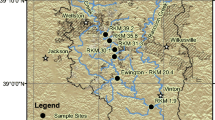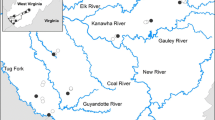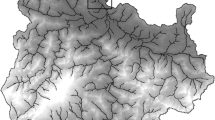Abstract
Assessments of watershed-based restoration efforts are rare but are essential for the science of stream restoration to advance. We conducted a watershed scale assessment of Abram Creek before and after implementation of a watershed-based plan designed to maximize ecological recovery from acid mine drainage (AMD) impairment. We surveyed water chemistry, physical habitat, benthic macroinvertebrates, and fish community structure in three stream types: AMD-impacted (14 streams), AMD-treated (13 streams), and unimpaired reference (4 streams). We used in-stream measurements to quantify ecological loss from AMD, the amount of ecological recovery expected through remediation, and the observed degree of post-treatment recovery. Sites impaired by AMD improved in water quality with AMD treatment. Dissolved metals and acidity declined significantly in treated streams, but sulfate and specific conductance did not. Likewise, sites impaired by AMD improved in bio-condition scores with AMD treatment. EPT genera increased significantly but were lower compared to unimpaired streams. We found fish at nine treated sites that had none before treatment. Community-level analyses indicated improved but altered assemblages with AMD treatment. Analysis of pre-treatment conditions indicated that only 30% of the historic fishery remained. Remediation was expected to recover 66% of the historic fishery value, and assessment of post-treatment conditions indicates that 52% of the historic fishery has been recovered after 3 years. Developing expected endpoints for restoration outcomes provides a tool to objectively evaluate successes and can guide adaptive management strategies.






Similar content being viewed by others
References
Bernhardt, E. S., Follstad-Shah, J., Galat, D., Gloss, S., Goodwin, P., Hart, D., Hassett, B., Jenkinson, R., Katz, S., Kondolf, G. M., Lake, P. S., Palmer, M. A., Lave, R., Meyer, J. L., O'Donnell, T. K., Pagano, L., Powell, B., Sudduth, E., Allan, J. D., Alexander, G., Barnas, K., Brooks, S., Carr, J., Clayton, S., & Dahm, C. (2005). Synthesizing U.S. river restoration efforts. Science, 308, 636–637.
Barbour, M. T., Gerritsen, J., Snyder, B. D., & Stribling, J. B. (1999). Rapid bioassessment protocols for use in streams and wadeable rivers: periphyton, benthic macroinvertebrates, and fish. Washington, DC: U. S. Environmental Protection Agency, Office of Water.
Bradley, D., & Ormerod, S. (2002). Long-term effects of catchment liming on invertebrates in upland streams. Freshwater Biology, 47, 161–171.
Brown, B. L., Swan, C. M., Auerbach, D. A., Campbell Grant, E. H., Hitt, N. P., Maloney, K. O., & Patrick, C. (2011). Metacommunity theory as a multispecies, multiscale framework for studying the influence of river network structure on riverine communities and ecosystems. Journal of the North American Benthological Society, 30, 310–327.
Campbell, D. (2000). Using energy systems theory to define, measure, and interpret ecological integrity and ecosystem health. Ecosystem Health, 6, 181–204.
DeNicola, D. M., & Stapleton, M. G. (2016). Using macroinvertebrates to assess ecological integrity of streams remediated for acid mine drainage. Restoration Ecology. doi:10.1111/rec.12366.
Development Core Team, R. (2013). R: a language and environment for statistical computing. Vienna: R Foundation for Statistical Computing.
Driscoll, C. T., Lawrence, G. G., Bulger, A. J., Butler, T. J., Cronan, C. S., Eagar, C., Lambert, K. F., Likens, G. E., Stoddard, J. L., & Weathers, K. D. (2011). Acidic deposition in the northeastern United States: sources and inputs, ecosystem effects, and management strategies. Bioscience, 51, 180–198.
Emerson, D. G., Vecchia, A. V., & Dahl, A. L. (2005). Evaluation of drainage-area ratio method used to estimate streamflow for the Red River of the North Basin, North Dakota and Minnesota. Reston: U.S. Geological Survery.
Flory, E. A., & Milner, A. M. (2000). Macroinvertebrate community succession in Wolf Point Creek, Glacier Bay National Park, Alaska. Freshwater Biology, 44, 465–480.
Freund, J. G., & Petty, J. T. (2007). Response of fish and macroinvertebrate bioassessment indices to water chemistry in a mined Appalachian watershed. Environmental Management, 39, 707–720.
Gerritsen, J., Burton, J., & Barbour, M. T. (2000). A stream condition index for West Virginia wadeable streams. Owings Mills: Tetra Tech, Inc..
Gore, J. A. (1982). Benthic invertebrate colonization: source distance effects on community composition. Hydrobiologia, 94, 183–193.
Gunn, J., Sarrazin-Delay, C., Wesolek, B., Stasko, A., & Szkokan-Emilson, E. (2010). Delayed recovery of benthic macroinvertebrate communities in Junction Creek, Sudbury, Ontario, after the diversion of acid mine drainage. Human and Ecological Risk Assessment, 16, 901–912.
Hansen, E., Collins, A., Zegre, S., & Hereford, A. (2010). The benefits of acid mine drainage remediation on the North Branch of the Potomac River. Morgantown, WV: Downstream Strategies.
Heidinger, R. C. (1999). Stocking for sport fisheries enhancement. In C. C. Kohler & W. A. Hubert (Eds.), Inland fisheries management in North America (2nd ed., pp. 375–401). Bethesda, Maryland: American Fisheries Society.
Heinrich, K. K., Whiles, M. R., & Roy, C. (2014). Cascading ecological responses to an in-stream restoration project in a midwestern river. Restoration Ecology, 22, 72–80.
Hilderbrand, R., Watts, A., & Randle, A. (2005). The myths of restoration ecology. Ecology and Society, 10, 19–19.
Jansson, R., Nilsson, C., & Malmqvist, B. (2007). Restoring freshwater ecosystems in riverine landscapes: the roles of connectivity and recovery processes. Freshwater Biology, 52, 589–596.
Lake, P. S., Bond, N., & Reich, P. (2007). Linking ecological theory with stream restoration. Freshwater Biology, 52, 597–615.
Louhi, P., Mykrä, H., Paavola, R., Huusko, A., Vehanen, T., Mäki-Petäys, A., & Muotka, T. (2011). Twenty years of stream restoration in Finland: little response by benthic macroinvertebrate communities. Ecological Applications, 21, 1950–1961.
McClurg, S. E., Petty, J. T., Mazik, P. M., & Clayton, J. L. (2007). Stream ecosystem response to limestone treatment in acid impacted watersheds of the Allegheny plateau. Ecological Applications, 17, 1087–1104.
McCormick, F. H., Hughes, R. M., Kaufmann, P. R., Peck, D. V., Stoddard, J. L., & Herlihy, A. T. (2001). Development of an index of biotic integrity for the Mid-Atlantic Highlands region. Transactions of the American Fisheries Society, 130, 857–877.
McGarigal, K., Cushman, S., & Stafford, S. G. (2000). Multivariate statistics for wildlife and ecology research. New York: Springer-Verlag.
Merovich Jr., G. T., & Petty, J. T. (2007). Interactive effects of multiple stressors and restoration priorities in a mined Appalachian watershed. Hydrobiologia, 575, 13–31.
Merovich Jr., G. T., Stiles, J. M., Petty, J. T., Ziemkiewicz, P. F., & Fulton, J. B. (2007). Water chemistry-based classification of streams and implications for restoring mined Appalachian watersheds. Environmental Toxicology and Chemistry, 26, 1361–1369.
Merovich Jr., G. T., Petty, J. T., Strager, M. P., & Fulton, J. B. (2013). Hierarchical classification of stream condition: a house-neighborhood framework for establishing conservation priorities in complex riverscapes. Freshwater Science, 32, 874–891.
Merriam, E. R., Petty, J. T., Merovich Jr., G. T., Fulton, J. B., & Strager, M. P. (2011). Additive effects of mining and residential development on stream conditions in a central Appalachian watershed. Journal of the North American Benthological Society, 30, 399–418.
Merriam, E. R., Petty, J. T., Strager, M. P., Maxwell, A. E., & Ziemkiewicz, P. F. (2015). Landscape-based cumulative effects models for predicting stream response to mountaintop mining in multistressor Appalachian watersheds. Freshwater Science, 34, 1106–1019.
Merritt, R. W., & Cummins, K. W. (2008). An introduction to the aquatic insects of North America (Fourth ed.). Dubuque: Kendall and Hunt.
Oksanen, J., Guillaume Blanchet, F., Kindt, R., Legendre, P., Minchin, P. R., O'Hara, R. B., Simpson, G. L., Solymos, P., Henry, M., Stevens, H., & Wagner, H. (2013). Vegan: community ecology package, R package version 2.0–10. Vienna: R Foundation for Statistical Computing.
Palmer, M. A., Bernhardt, E. S., Allan, J. D., Lake, P. S., Alexander, G., Brooks, S., Carr, J., Clayton, S., Dahm, C. N., Shah, J. F., Galat, D. L., Loss, S. G., Goodwin, P., Hart, D. D., Hassett, B., Jenkinson, R., Kondolf, G. M., Lave, R., Meyer, J. L., O'Donnell, T. K., Pagano, L., & Sudduth, E. (2005). Standards for ecologically successful river restoration. Journal of Applied Ecology, 42, 208–217.
Peckarsky, B. L., Fraissinet, P. R., Penton, M. A., & Conklin, D. J. (1990). Freshwater macroinvertebrates of northeastern North America. Ithaca: Cornell University Press.
Petty, J. T., & Thorne, D. (2005). An ecologically based approach to identifying restoration priorities in an acid-impacted watershed. Restoration Ecology, 13, 348–357.
Petty, J. T., B. Gutta, R. Herd, J. Fulton, J. Stiles, M. Strager, J. Svetlick, and P. Ziemkiewicz. (2008). Identifying cost-effective restoration strategies in mining impacted West Virginia watersheds. 25th Annual Meetings of the American Society of Mining and Reclamation and 10th Meeting of IALR. Richmond, Virginia, USA.
Petty, J. T., Fulton, J. B., Strager, M. P., Merovich Jr., G. T., Stiles, J. M., & Ziemkiewicz, P. F. (2010). Landscape indicators and thresholds of stream ecological impairment in an intensively mined Appalachian watershed. Journal of the North American Benthological Society, 29, 1292–1309.
Pond, G. J., Passmore, M. E., Borsuk, F. A., Reynolds, L., & Rose, C. J. (2008). Downstream effects of mountaintop coal mining: comparing biological conditions using family- and genus-level macroinvertebrate bioassessment tools. Journal of the North American Benthological Society, 27, 717–737.
Simmons, J. A., Lawrence, E. R., & Jones, T. G. (2005). Treated and untreated acid mine drainage effects on stream periphyton biomass, leaf decomposition, and macroinvertebrate diversity. Journal of Freshwater Ecology, 20, 413–424.
Simon, M. L., Cherry, D. S., Currie, R. J., & Zipper, C. E. (2012). The ecotoxicological recovery of Ely Creek and tributaries (Lee County, VA) after remediation of acid mine drainage. Environmental Monitoring and Assessment, 184, 2559–2574.
Strager, M. P., Petty, J. T., & Strager, J. M. (2009). A spatially explicit framework for quantifying downstream hydrologic conditions. Journal of Environmental Management, 90, 1854–1861.
Sundermann, A., Stoll, S., & Haase, P. (2011). River restoration success depends on the species pool of the immediate surroundings. Ecological Applications, 21, 1962–1971.
Trushenski, J., Flagg, T., & Kohler, C. (2010). Use of hatchery fish for conservation, restoration, and enhancement of fisheries. In W. A. Hubert & M. C. Quist (Eds.), Inland fisheries management in North America (3rd ed., pp. 261–293). Bethesda, Maryland: American Fisheries Society.
TU (Trout Unlimited). (2011). The West Branch Susquehanna recovery benchmark project. Lock Haven: Trout Unlimited’s Eastern Abandoned Mine Program.
USEPA (United States Environmental Protection Agency). (2000). Mid-Atlantic Highlands streams assessment: final report by Environmental Monitoring and Assessment Program, National Health and Environmental Effects Research Laboratory, Western Ecology Division, Office of Research and Development & Region III, Washington, D.C., USA.
Vieira, N. K. M., Clements, W. H., Guevara, L. S., & Jacobs, B. F. (2004). Resistance and resilience of stream insect communities to repeated hydrologic disturbances after a wildfire. Freshwater Biology, 49, 1243–1259.
WVDEP (West Virginia Department of Environmental Protection). (2013). Benthic invertebrate sampling, processing, and analysis: standard operating procedures. Charleston: West Virginia Division of Environmental Protection.
WVWRI (West Virginia Water Research Institute), National Mine Land Reclamation Center, Watershed Technical Assistance Center, West Virginia University. (2007). Abram Creek watershed restoration plan. Morgantown: West Virginia University.
Zuellig, R. E., Kondratieff, B. C., & Rhodes, H. A. (2002). Benthos recovery after an episodic sediment release into a Colorado Rocky Mountain river. Western North American Naturalist, 62, 59–72.
Acknowledgements
We thank Donna Hartman, Eric Merriam, Eric Miller, Brock Huntsman, and Alison Anderson for their help in field sampling and laboratory analysis. We thank Jim Baczuk from WVDEP Office of Abandoned Mine Lands and Reclamation for sharing his expertise and overlooking the operation and maintenance for the Abram Creek watershed remediation project. This work was funded, in part, by the Appalachian Research Initiative for Environmental Science, the West Virginia Water Research Institute, and West Virginia University, School of Natural Resources. All sampling was approved by The Institutional Animal Care and Use Committee (IACUC) of West Virginia University (most recent protocol number 11–0507).
Author information
Authors and Affiliations
Corresponding author
Rights and permissions
About this article
Cite this article
Watson, A.S., Merovich, G.T., Petty, J.T. et al. Evaluating expected outcomes of acid remediation in an intensively mined Appalachian watershed. Environ Monit Assess 189, 339 (2017). https://doi.org/10.1007/s10661-017-6036-x
Received:
Accepted:
Published:
DOI: https://doi.org/10.1007/s10661-017-6036-x




